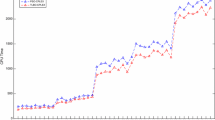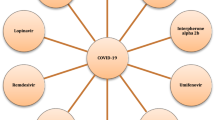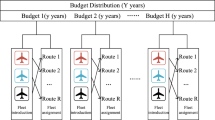Abstract
Service systems are in significant danger of terrorist attacks aimed at disrupting their critical components. These attacks seek to exterminate vital assets such as transportation networks, services, and supplies. In the present paper, we propose a multi-period planning based on capacity recovery to allocate fortification/interdiction resources in a service system. The problem involves a dynamic Stackelberg game between a defender (leader) and an attacker (follower). The decisions of the defender are the services provided to customers and the fortification resources allocated to facilities in each period as the total demand-weighted distances are minimized. Following this, the attacker allocates interdiction resources to facilities that resulted in the service capacity reduction in each period. In this model, excess fortification/interdiction budgets and capacity in one period can be used in the next period. Moreover, facilities have a predefined capacity to serve the customers with varying demands during the time horizon. To solve this problem, two different types of approaches are implemented and compared. The first method is an exact reformulation algorithm based on the decomposition of the problem into a restricted master problem (RMP) and a slave problem (SP). The second one is a high performance metaheuristic algorithm, i.e., genetic algorithm (GA) developed to overcome the decomposition method’s impracticability on large-scale problem instances. We also compare the results with some novel metaheuristic algorithms such as teaching learning based optimization (TLBO) and dragonfly algorithm (DA). Computational results show the superiority of GA against TLBO and DA.




Similar content being viewed by others
References
Abhiraj TK, Aravindhababu P (2017) Dragonfly optimization based reconfiguration for voltage profile enhancement in distribution systems. Int J Comput Appl 158(3):1–4
Afshari-Rad M, Taghizadeh-Kakhki H (2013) Maximum dynamic network flow interdiction problem: New formulation and solution procedures. Comput Ind Eng 65:531–536
Aksen D, Aras N (2012) A bilevel fixed charge location model for facilities under imminent attack. Comput Oper Res 39:1364–1381
Aksen D, Akca SS, Aras N (2014) A bilevel partial interdiction problem with capacitated facilities and demand outsourcing. Comput Oper Res 41(1):346–358
Aliakbarian N, Dehghanian F, Salari M (2015) A bilevel programming model for protection of hierarchical facilities under imminent attacks. Comput Oper Res 64:210–224
Aras N, Aksen D (2008) Locating collection centers for distance and incentive dependent returns. Int J Prod Econ 111(2):316–333
Bashishtha TK, Srivastava L (2016) Nature inspired meta-heuristic dragonfly algorithms for solving optimal power flow problem. International Journal of Electronics. Electr Comput Syst 5(5):111–120
Benders J (1962) Partioning procedures for solving mixed integer variables programming problems. Num Math 4:238–252
Calvete HI, Gale C, Mateo PM (2008) A new approach for solving linear bilevel problems using genetic algorithms. Eur J Oper Res 188:14–28
Church RL, Scaparra MP, Middleton RS (2004) Identifying critical infrastructure: the median and covering facility interdiction problems. Ann Assoc Amer Geogr 94(3):491–502
Church RL, Scaparra MP (2007) Protecting critical assets: the r-interdiction median problem with fortification. Geogr Anal 39(2):129–646
Eiselt HA, Marianov V (2015) Applications of location analysis. Springer Cham Heidelberg, New York
Gabriel SA, Shim Y, Conejo AJ, de-la-Torre S, Garcia-Bertrand R (2010) A Benders decomposition method for discretely constrained mathematical programs with equilibrium constraints. J Oper Res Soc 61:1404–1419
Geyik F, Cedimoglu IH (2004) The strategies and parameters of tabu search for job-shop scheduling. J Intell Manuf 15(4):439–448
Hansen P, Jaumard B, Savard G (1992) New branch and bound rules for linear bilevel programming. SIAM J Sci Stat Comput 13:1194–1217
Hejazi SR, Memariani A, Jahanshahloo G, Sepehri MM (2002) Linear bilevel programming solution by genetic algorithm. Comput Oper Res 29:1913–1925
Holland JH (1975) Adaptation in natural and artificial systems: an introductory analysis with applications to biology, control and artificial intelligence. MIT Press, Cambridge
http://www.ibm.com/ [Accessed 02 August 2017]
Jaramillo JH, Bhadury J, Batta R (2002) On the use of genetic algorithms to solve location problems. Comput Oper Res 29:761–779
Kratica J, Tosic D, Filipovic V, Ljubic I (2001) Solving the simple plant location problem by genetic algorithm. RAIRO Oper Res 35:127–142
Liberatore F, Scaparra MP, Daskin MS (2011) Analysis of facility protection strategies against an uncertain number of attacks: the stochastic r-interdiction median problem with fortification. Comput Oper Res 38(1):357–366
Losada C, Scaparra MR, Church RL (2010) On a bilevel formulation to protect uncapacitated p-median systems with facility recover time and frequent disruptions. Electron Note Discret Math 36:591–598
Lunday BJ, Sherali HD (2010) A dynamic network interdiction problem. Informatica 21(4):553–574
Malaviya A, Raiwater C, Shakey T (2012) Multi-period network interdiction problems with applications to city-level drug enforcement. IIE Trans 44:368–380
Maleki HR, Khanduzi R (2016) Fuzzy interdiction/fortification location problems on p-median systems. J Intell Fuzzy Syst 30(3):1283–1292
Maleki HR, Khanduzi R, Akbari R (2016) A novel hybrid algorithm for solving continuous single-objective defensive location problem. Neural Computer & Application https://doi.org/10.1007/s00521-016-2254-3
Maric M (2010) An efficient genetic algorithm for solving the multi-level uncapacitated facility location problem. Comput Inf 29:183–201
Mirjalili S (2015) Dragonfly algorithm: a new meta-heuristic optimization technique for solving single-objective, discrete, and multi-objective problems. Neural Computer & Application https://doi.org/10.1007/s00521-015-1920-1
Nishizaki I, Sakawa M (2000) Computational methods through genetic algorithms for obtaining Stackelberg solutions to two-level mixed zero-one programming problems. Cybern Syst 31:203–221
Nguyen BU, Ng KYK (2000) Modeling Canadian search and rescue operations. Mil Oper Res 5(1):5–16
Park MW, Kim YD (1998) A systematic procedure for setting parameters in simulated annealing algorithms. Comput OpsRes 25(3):207–217
Pasricha R, Wadhwa V (2011) Optimizing facility location problem using genetic algorithm. Int J Comput Sci Telecommun 2(3):13–15
Pathania AK, Mehta S, Rza C (2016) Multi-objective dispatch of thermal system using dragonfly algorithm. Int J Eng Res 5(11):861–866
Rao RV, Savsani VJ, Vakharia DP (2011) Teaching learning based optimization: a novel method for constrained mechanical design optimization problems. Comput-Aided Des 43(3):303–315
Rao RV, Savsani VJ, Vakharia DP (2012) Teaching learning based optimization: an optimization method for continuous non-linear large scale problems. Inf Sci 183(1):1–15
Roth JP (1998) The logistics of the Roman Army at war (264 B.C.A.D 235). Brill, Leiden
Scaparra MP, Church RL (2008) A bilevel mixed integer program for critical infrastructure protection planning. Comput Oper Res 35(6):1905–1923
Starita S, Scaparra MP (2016) Optimizing dynamic investment decisions for railway systems protection. Eur J Oper Res 248:543–557
Wang G, Wang X, Wan Z, Jia S (2007) An adaptive genetic algorithm for solving bilevel linear programming problem. Appl Math Mech-Engl Ed 28:1605–1612
Yang Z, Li K, Zhang L (2016) Binary teaching-learning based optimization for power system unit commitment. In: UKACC 11th International Conference on Control (CONTROL), Belfast
Zheng J, Castanon DA (2012) Dynamic network interdiction games with imperfect information and deception. In: 51st IEEE Conference on Decision and Control, Maui
Zhu Y, Zheng Z, Zhang X, Cai K (2013) The r-interdiction median problem with probabilistic protection and its solution algorithm. Comput Oper Res 40:451–462
Acknowledgements
The first author would like to thank the research council of Gonbad Kavous University for supporting this research work. The second author would like to appreciate the research council of Shiraz University of Technology for supporting this research.
Author information
Authors and Affiliations
Corresponding author
Rights and permissions
About this article
Cite this article
Khanduzi, R., Maleki, H.R. A novel bilevel model and solution algorithms for multi-period interdiction problem with fortification. Appl Intell 48, 2770–2791 (2018). https://doi.org/10.1007/s10489-017-1116-8
Published:
Issue Date:
DOI: https://doi.org/10.1007/s10489-017-1116-8




